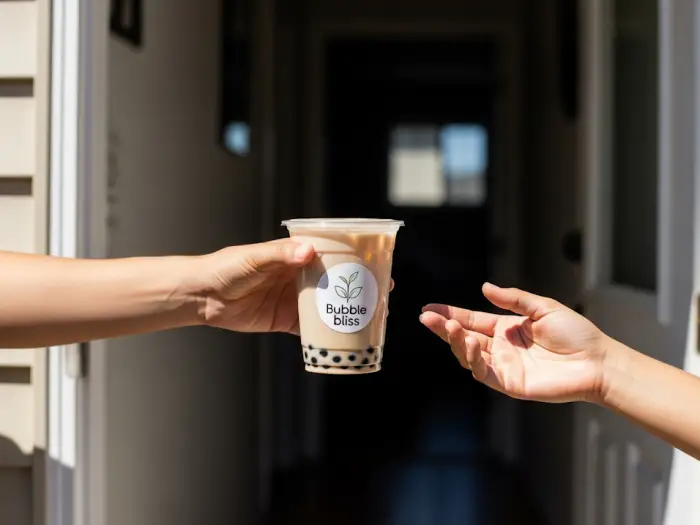Nakita mo ba ang dami ng milk tea shops at stalls kahit saan ngayon? Here in the Philippines, milk tea isn’t just a drink; it’s a phenomenon! From a simple treat, it has become a daily habit for many, and the market is still growing stronger every day.
- 📈 The Milk Tea Market in the Philippines: Trends and Opportunities
- 🍵 The ‘Pinoy’ Milk Tea Lab: Recipes, Menu & Quality Control
- 💰 The ‘Wais’ Entrepreneur’s Playbook: Smart Sourcing & Capital
- 📈 Pricing Strategy & Profit Margins
- 🚚 From Kitchen to Customers: Mastering Logistics & Service
- 📲 Social Media ‘Sikat’: Building Your Brand & Buzz
- 📄 Making It Official: Permits and Registrations
- 🚧 Common Challenges & How to Overcome Them
- 📈 Leveling Up Your Negosyo: Scaling for Success
- ❓ Frequently Asked Questions About the Milk Tea Business
- ✅ Your 3-Point Takeaway Plan
- 🏁 Your Milk Tea Business Journey
Starting a milk tea business is a great way to tap into this trend. It’s a venture with a relatively low startup capital, and because of its popularity, the potential for profit is huge. The best part? You don’t need a big, fancy shop. Many successful entrepreneurs started right from their own home or a small stall.
This comprehensive guide is your complete roadmap to building a successful home-based milk tea business. We will walk you through everything, from creating your signature recipe and managing your inventory to building your brand and growing your business.
Ready to mix your first batch of success? Kaya mo ‘yan, ka-negosyo! Let’s start this exciting journey together.

📈 The Milk Tea Market in the Philippines: Trends and Opportunities
You’re not just selling a drink; you’re joining a billion-peso industry! The milk tea market in the Philippines is thriving, and new brands are popping up everywhere. But don’t worry, the market is still big enough for a new player like you to succeed, especially when you know how to find your place in it.
Spotting the Opportunity in the Crowd
The key to standing out is finding your unique niche. Instead of trying to be everything to everyone, focus on a specific market that you can serve better than anyone else. Here are a few business models you can consider:
- The Home-Based Delivery Model: This is perfect for beginners. Your market is your immediate neighborhood, friends, and family. It requires a low capital, and you can test your recipes and marketing strategies without the pressure of a physical store. This is the ideal way to start a home-based milk tea business.
- The Mobile Kiosk or Stall: If you have more capital and want to reach a wider audience, a small kiosk in a high-traffic area, like outside a school, office building, or even a public park, can work wonders. This model thrives on impulse buys and convenience.
- The Niche Flavor Specialist: You can become known for something unique. Maybe you use only organic ingredients, or you specialize in a specific type of drink, like fruit-based milk tea with fresh toppings. By having a specialty, you give customers a reason to choose you over a generic brand.
Understanding Your Customer
Think about who you want to sell to. Are you targeting students who are looking for an affordable treat? Are you trying to appeal to young professionals who prefer high-quality, artisanal ingredients? Your target customer will determine your price point, your menu, and even your branding. For example, if you’re targeting students, your marketing might be fun and trendy, using social media platforms like TikTok to create viral content.
By taking the time to define your niche and understand your market, you are already one step ahead of the competition. It’s the first and most important step to turning your passion into a profitable and sustainable business.

🍵 The ‘Pinoy’ Milk Tea Lab: Recipes, Menu & Quality Control
The secret to a successful milk tea business isn’t just about having the best ingredients; it’s about crafting a drink that people will keep coming back for. Now that you have your supplies, let’s learn how to make your milk tea stand out.
☕ The Basic Milk Tea Recipe: A Scientific Approach
Before you start experimenting with different flavors, master the classic milk tea recipe. It’s the foundation of your business, and consistency is key. Think of your kitchen as a lab, where every measurement matters.
Ingredients
- 100g Black Tea Leaves
- 1L Water
- 100g Non-Dairy Creamer
- 100ml Fructose Syrup
- Cooked Tapioca Pearls
- Ice
Instructions
- Brew the Tea: In a large pot, bring the water to a rolling boil. Add the black tea leaves, turn off the heat, and let it steep for exactly 15-20 minutes. Straining the tea leaves and setting the brewed tea aside. Using a timer here is critical to prevent over-steeping, which can make your tea bitter.
- Make the Milk Tea Base: While the tea is still warm, mix in the non-dairy creamer and fructose syrup until they are fully dissolved. This will be your base mixture.
- Prepare a Drink: In a shaker, add your base mixture and ice. Shake well until a nice foam forms. Pour it into a cup and add your cooked tapioca pearls.
📋 Planning a Menu That Sells
When you’re starting, don’t try to offer too many flavors at once. It’s better to perfect a few and then expand later on. Here is a sample menu you can use as a reference:
| Category | Recommended Flavors | Why They Sell |
|---|---|---|
| Classics | Classic, Wintermelon, Okinawa | These are the bestsellers and the foundation of your menu. Wintermelon, for example, is widely popular here and has a sweet, smoky flavor that’s a crowd-pleaser. |
| Fruit-Based | Taro, Strawberry, Mango | Fruit-based milk tea provides a refreshing alternative, especially during the hot summer months. Taro is a familiar flavor to many Filipinos and a must-have on any menu. |
| Cream Cheese/Rock Salt | Oreo, Red Velvet, Matcha | These are premium flavors that can command a higher price. They appeal to customers looking for something more indulgent or unique, like the rich, earthy taste of matcha. |
| Add-Ons / Sinkers | Tapioca Pearls, Nata de Coco, Pudding | Don’t underestimate the power of add-ons! They’re a simple way to increase your profit per cup and give customers the ability to customize their drink. |
Remember, consistency is key! Your milk tea should taste the same every single time, no matter who makes it. This is what will build trust with your customers and turn them into loyal suki.

💰 The ‘Wais’ Entrepreneur’s Playbook: Smart Sourcing & Capital
Siyempre, ka-negosyo, before you start, you have to know how much money you’ll need to prepare. One of the best things about a milk tea business is that it doesn’t require a huge amount of money to start. You can be flexible and adjust your capital depending on your starting scale.
💵 Sourcing Your Ingredients & Suppliers
Finding reliable milk tea suppliers is the key to a good and profitable business. You want suppliers who offer good quality ingredients at a low price.
- Online Suppliers: You can find many reputable milk tea suppliers on e-commerce platforms like Shopee and Lazada. They often offer wholesale prices and deliver right to your doorstep, which is perfect for a home-based milk tea business.
- Local Stores: Visit baking supply stores or specialty food shops in your area. You can often buy in bulk and build a relationship with the store owner for future deals.
📊 Your Initial Milk Tea Business Capital
For a home-based milk tea business (selling to your family, neighbors, and friends), your initial capital can be as low as ₱1,000 to ₱3,000. This is your most basic investment, focusing only on the essentials to make your first 50-100 cups.
Here’s a sample breakdown:
| Item | Estimated Price (PHP) | Notes |
|---|---|---|
| Starter Kit (Ingredients & Equipment) | ₱1,010 – ₱1,770 | This includes tea leaves, flavored powders, pearls, non-dairy creamer, and a manual shaker. |
| Cups & Straws (for 50 cups) | ₱150 – ₱250 | A basic set of plastic cups and straws. |
| Initial Advertising (online) | ₱500 – ₱1,000 | For boosting your Facebook page or creating simple marketing materials. |
| Total | ₱1,660 – ₱3,020 | Your total initial investment. |
⭐ Example: A Wais Entrepreneur’s Story
Narinig ko ang kwento ni Marie, isang college student sa Maynila na gustong magsimula ng negosyo ng milk tea. She didn’t have much money, so she started by buying a milk tea starter kit online for just ₱1,500. It came with just enough ingredients for 50 cups. Instead of renting a stall, she announced her business on her personal Facebook account, offering free delivery to her friends in their dorms. In just one weekend, she sold all 50 cups, earning a profit of over ₱1,000. She used that profit to buy more ingredients in bulk, and soon, her small home-based milk tea business was growing.
This simple story shows that you don’t need a lot of money to start. You just need to be smart and resourceful.

📈 Pricing Strategy & Profit Margins
After you’ve figured out your initial capital and secured your supplies, the next big question is: how much should you sell your milk tea for? This section will teach you how to set a price that is competitive but also ensures you are making a good profit.
Calculating Your Cost Per Cup
This is a key step to setting the right price. You need to know exactly how much each cup of milk tea costs you to make. It’s a simple calculation:
Cost Per Cup = Total Cost of Ingredients / Number of Cups Produced
Let’s use our sample capital breakdown for an example:
- Cost of Ingredients: ₱1,010 – ₱1,770
- Number of Cups: 50
- Cost Per Cup: ₱1,010 / 50 = ₱20.20
This means that each cup of classic milk tea costs you about ₱20.20 to make. Now you can set a price that is profitable for you.
Setting Your Price
Now that you know your cost, you can set a price. A general rule of thumb is to aim for a profit margin of at least 50% to 60%.
- Price Per Cup: (Cost Per Cup / 50%) + Cost Per Cup
- Price Per Cup: (₱20.20 / 0.50) + ₱20.20 = ₱40.40
This calculation gives you a good starting point. You can now adjust your price based on what other milk tea shops in your area are selling for. Just remember to always keep an eye on your costs!

🚚 From Kitchen to Customers: Mastering Logistics & Service
Minsan, ka-negosyo, getting the perfect drink to your customer can be as important as making it. This is where we’ll talk about how to manage your orders, handle delivery, and build a reputation for great customer service. A smooth process from order to delivery will keep your customers coming back.
📝 A Simple System for Order Management
Even with just a few orders, it’s easy to get confused. A simple notebook or a spreadsheet on your phone is a great start. When a customer places an order, you can write down the following details:
- Customer Name: Always get the full name.
- Order: The specific flavors, sizes, and add-ons.
- Total Price: The final amount the customer needs to pay.
- Payment Method: Did they pay via GCash, bank transfer, or cash on delivery?
- Delivery Details: The exact address and preferred delivery time.
By doing this, you’ll know exactly how many drinks you need to prepare and how much of each ingredient you’ve used. This helps you track your sales and know when to restock your milk tea suppliers.
🛵 Choosing Your Delivery Method
One of the biggest challenges for a home-based milk tea business is delivery. You need to make sure your drinks get to your customers quickly and in perfect condition.
Here are some options for you to consider:
| Delivery Method | Pros | Cons |
|---|---|---|
| In-House Delivery | You have full control over the delivery. You can deliver to your family, friends, or neighbors yourself, saving on fees. | Can be time-consuming and limit your reach. You’ll need to handle your own scheduling. |
| Third-Party Apps (Grab, Lalamove, etc.) | You can reach a much wider customer base. They handle the delivery logistics for you. | They charge a commission fee per order, which can lower your profit margin. |
| Customer Pick-up | Zero delivery fees for you and the customer. Perfect for nearby customers who want to save on fees. | Not all customers can pick up their orders, limiting your sales. |
❤️ Building Customer Loyalty with Great Service
Here in the Philippines, word of mouth is powerful. A happy customer can become your best marketer, especially on social media.
- Excellent Communication: Respond to inquiries and orders quickly and kindly. Be transparent about stock availability and delivery schedules. A simple “Salamat po!” goes a long way.
- Go the Extra Mile: Small gestures can make a huge difference. For example, you can include a personalized thank-you note, add a small sticker of your business logo, or even give a small discount on their next order. It’s a small touch that leaves a lasting impression and makes your customer feel special.

📲 Social Media ‘Sikat’: Building Your Brand & Buzz
Once you have your first batch of drinks ready, it’s time to let the world know about your milk tea business. In today’s market, social media is your most powerful tool for attracting customers and building a brand that people will love.
🌟 Creating a Brand that Pops
- Choose a Catchy Name: Pick a name that is easy to remember and reflects your brand. For example, “Milk Tea on the Go” or “The Daily Sip.”
- Design a Logo: A simple logo can make your business look professional and trustworthy. You can even design one for free using online tools.
- Take Great Photos: Milk tea is very visual! Use natural light to take photos of your drinks. Showcase the vibrant colors, the perfect layering, and the fun toppings. A well-lit, high-quality photo can make people crave your drinks.
📱 Engaging Content that Sells
Social media isn’t just about selling; it’s about connecting with your customers. The more you engage with them, the more likely they are to buy from you.
| Content Type | Example | Why it works |
|---|---|---|
| Behind-the-Scenes | Share a short video of you brewing the tea or preparing a fresh batch of pearls. | It shows your customers how much care and effort you put into every drink. It builds trust and authenticity. |
| Customer Features | Ask your customers to tag your page in their photos. You can then repost their photos on your page. | It’s a great way to get free promotion and makes your customers feel special. It also shows potential buyers that people are genuinely enjoying your product. |
| Polls & Questions | Ask your followers, “What’s your favorite milk tea flavor?” or “What new flavor should we add to our menu?” | It gets people talking and gives you valuable information about what your customers want. |
| Promos & Contests | “Buy two, get one free!” or “Tag a friend to win a free milk tea!” | These can quickly increase your sales and help your business get noticed by a wider audience. |
💬 The Power of Word-of-Mouth
Here in the Philippines, a good recommendation from a friend or family member is gold. When you provide an amazing product and great service, people will naturally talk about your business. Encourage this by asking your customers to leave a review or share a photo on their page. A happy customer is the best marketer you can ever have!

📄 Making It Official: Permits and Registrations
So, you’ve started making and selling your delicious milk tea! As your business grows, you might want to make it official. While a home-based milk tea business is often a small venture, getting the right permits and registrations is a smart move that can give you credibility and access to more opportunities.
📝 Why Permits Are Important
- Credibility and Trust: Having a registered business makes you look more professional and trustworthy to your customers.
- Legal Protection: It protects you as a business owner and allows you to operate without worrying about legal issues.
- Access to Suppliers: Some suppliers or partners may require you to have a registered business before they can work with you.
- Access to Business Loans: If you want to expand your milk tea business in the future, a registered business is often required to get a loan or financial assistance.
🏢 The Step-by-Step Permit Process
Here in the Philippines, the permit process can be a bit confusing. But don’t worry, here are the basic steps you’ll need to follow:
- Barangay Business Clearance: This is your very first step. It is the basic permit you’ll need to operate within your barangay.
- DTI Registration: If you are a single proprietor, you will need to register your business name with the Department of Trade and Industry (DTI). This gives you the exclusive right to use your business name.
- Mayor’s Business Permit: After you get your DTI registration, you’ll need to apply for a Business Permit from your City or Municipal Hall.
- BIR Registration: If your annual gross sales exceed a certain amount, you’ll need to register with the Bureau of Internal Revenue (BIR) to pay taxes.
Huwag kang mag-alala, you don’t need to do all of these right away. Many small home-based businesses start with just a Barangay Business Clearance and DTI registration. The most important thing is to do your research and take the right steps as your business grows.
🚧 Common Challenges & How to Overcome Them
No business journey is without its challenges. By knowing what to look out for, you can be better prepared to overcome them and keep your milk tea business running smoothly.
- Fierce Competition: The milk tea market is saturated, and new shops are constantly popping up. You can stand out by focusing on a specific niche, providing excellent customer service, or creating a unique brand that customers love.
- Supply Shortages: Sometimes, a specific ingredient or your favorite brand of pearl might be out of stock. Always have a list of backup suppliers so you’re never caught off guard. You can also buy in bulk when you find a good deal to avoid running out of stock.
- Managing Perishables: Ingredients like tapioca pearls, milk, and fresh fruit have a limited shelf life. To prevent waste, buy only what you need and store them properly. Always track your sales so you can accurately predict how much you’ll need for the week.
- Wastage: Overproducing drinks can lead to wasted ingredients. A simple fix is to prepare your tea base and toppings in small batches, so you can easily adjust based on your daily orders.
By being aware of these potential challenges, you can plan ahead and create solutions before they become a major problem for your milk tea business.

📈 Leveling Up Your Negosyo: Scaling for Success
Starting a home-based milk tea business is a great first step, but what happens when the orders keep pouring in? The next challenge is to grow and scale your operations without sacrificing the quality of your drinks or your customer service.
🔄 Streamlining Your Operations
As your orders increase, you’ll need a more efficient system. Instead of making drinks one by one, you can prepare a large batch of your tea base every morning. This way, when an order comes in, all you have to do is mix, shake, and serve. This simple change can cut your prep time in half and allow you to serve more customers in a day.
⭐ Example: Upgrading Your Equipment
Kuwento ng isang kaibigan ko, when she first started her milk tea business, she used a manual shaker and a small pot. When her daily orders grew to over 50 cups, she realized she couldn’t keep up. She invested her profits into an electric blender and a larger stockpot. This small upgrade allowed her to prepare more drinks faster and accept more orders, which helped her double her income.
| Upgrade | Benefit |
|---|---|
| Electric Shaker/Blender | Makes prep faster and more consistent. |
| Bigger Stock Pot | Allows you to brew a larger batch of tea base at once. |
| Cup Sealing Machine | Makes your cups look professional and spill-proof, which is great for deliveries. |
🌱 Expanding Your Reach
Once you’ve maximized your home-based operations, you can start thinking about expanding your reach. You can partner with local businesses, such as a sari-sari store or a small turo-turo stall, to sell your products. This is a great way to reach new customers without the huge cost of setting up your own physical store.
📈 When to Consider a Physical Stall
- Consistent Demand: You consistently receive a high volume of orders every day.
- Capital for Expansion: You’ve saved enough money to cover the rent, new equipment, and other expenses.
- Brand Recognition: Your brand is well-known in your area, and people are already familiar with your products.
Remember, leveling up is a gradual process. The key is to always be a “wais” entrepreneur and make smart decisions at every step of your milk tea business journey.
❓ Frequently Asked Questions About the Milk Tea Business
We know you probably have a lot of questions before you start. Here are some of the most common ones that new entrepreneurs ask.
- How much is the average cost to start a milk tea business in the Philippines? Your initial capital can be as low as ₱1,000 to ₱3,000 for a small, home-based business. If you are aiming for a full-scale stall, the cost can be ₱50,000 or more, depending on your location and equipment.
- Is the milk tea business still profitable? Yes! The demand for milk tea here in the Philippines continues to be strong. By being resourceful with your capital and providing a high-quality product, your business can be very profitable.
- Where can I buy affordable milk tea supplies? You can find affordable milk tea suppliers on platforms like Shopee and Lazada. You can also visit local baking supply stores or check with other milk tea business owners for their supplier recommendations.
- Do I need a franchise to be successful? No, a franchise is not a requirement for success. Many successful milk tea business owners started as independent sellers. It allows you to have full control over your brand, recipes, and profits.
- How do I choose the right milk tea flavors? Start with the classics like wintermelon, classic, and Okinawa, as these are very popular. You can add more flavors to your menu as your business grows and as you get to know what your customers prefer.
- Can I start this business while working or studying? Absolutely! A home-based milk tea business is very flexible. You can manage your orders and prep in the mornings or evenings, making it a great part-time venture for students and professionals.
- How can I make my milk tea taste better than others? The key is consistency and quality ingredients. Always follow your recipe, use high-quality tea leaves and non-dairy creamer, and don’t be afraid to experiment to find your own unique and delicious blend.
- What are some of the biggest challenges for a small milk tea business? Some challenges include managing inventory, handling delivery logistics, and standing out in a competitive market. The best way to overcome these is by having a solid business plan and providing excellent customer service.
- Is it necessary to get a DTI or Mayor’s Permit right away? For a very small home-based milk tea business, you can start with a Barangay Business Clearance first. As your business grows and your income increases, it’s a good idea to register with the DTI and get your other business permits.
- What’s the best way to price my drinks? You can calculate your costs (ingredients, cups, delivery, etc.) and add a profit margin on top of that. Remember to also look at your competitors’ prices in your area to stay competitive.
✅ Your 3-Point Takeaway Plan
Ready to get started? Here is a simple, 3-point plan to help you take that first step toward your own successful milk tea business.
- Start Small, Dream Big: Don’t be afraid to start with a minimal capital. Use your own kitchen and sell to your friends and family first. This allows you to test your ideas and build a customer base without any huge risks.
- Master Your Craft: The secret to a lasting business is a great product. Focus on perfecting your recipes and ensure your milk tea tastes consistently amazing. Your customers will notice and keep coming back for more.
- Use Your Network: Your friends, family, and social media followers are your first and most powerful marketers. Use your network to spread the word about your milk tea business and turn your happy customers into your most effective sales team.
🏁 Your Milk Tea Business Journey
Congratulations, you’ve reached the end of this comprehensive guide! Now you have all the tools and knowledge you need to start your very own milk tea business from the comfort of your home.
Remember that every great business starts with a single step. Be prepared, be resourceful, and most importantly, be passionate about your product. The milk tea market is full of opportunities, and your hard work and creativity can turn your dream into a sweet and profitable reality.
Huwag kang matakot magsimula! You have a great idea and a passion to succeed. We hope this guide inspires you to take that first step and start brewing your way to success.











